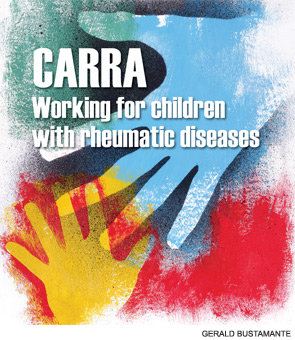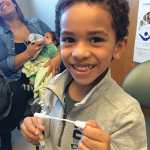
What a difference a decade makes. In the late 1980s and early 1990s, the viability of pediatric rheumatology seemed in doubt. Few fellows were being trained, and medical centers were fortunate if they had even one pediatric rheumatologist on staff. The paucity of trained pediatric rheumatologists created severe access problems for children with disorders like juvenile idiopathic arthritis (JIA) and pediatric lupus. Depending on where they lived, children needing care for a rheumatic disease might be treated by an adult rheumatologist—or no rheumatologist at all.
Looking at pediatric rheumatology from an academic perspective, research was difficult because many of the diseases are rare and affected children live all over the country and are unable to receive care at research centers. Christy Sandborg, MD, had just moved to Stanford University (Calif.) as a pediatric rheumatologist, and she was worried. “Even though you could do important research in a laboratory, I wondered what good it would do without access to the kids who had these diseases,” she says.
Then the combination of some unexpected funding and expert brainstorming led to a new start for this field, and the creation of the Childhood Arthritis and Rheumatology Research Alliance, (CARRA). A small family foundation, The Wasie Foundation of Minnesota, was interested working with the Arthritis Foundation (AF) to contribute to the acceleration of research in pediatric rheumatology. “I was asked to attend a meeting to discuss research needs,” says Betsy Mellins, MD, professor of pediatrics at Stanford University. “My own work had made me aware of opportunities for advances through bench research. However, when Brian Feldman [MD, MSc, now professor of pediatrics and head of the division of rheumatology at The Hospital for Sick Children in Toronto, and senior scientist at University of Toronto in Ontario, Canada] suggested the highest immediate impact would come from enhancing infrastructure for cooperative clinical research, I was quickly converted.”
With funding from The Wasie Foundation and the Lucile Packard Foundation for Children’s Health and organizational support from the AF, Dr. Mellins convened a meeting with experts from active clinical research networks in other specialties, particularly networks of pediatricians. “We wanted to hear about their past experience and their future plans in order to choose features that would be a ‘best fit’ for pediatric rheumatology,” she explains. Importantly, this meeting led to the formation of a committed and energetic Pediatric Rheumatology Research Network Steering Committee, with Dr. Mellins as chair. The goal of the committee was the creation of a network for investigator-initiated studies, thereby complementing the existing Pediatric Rheumatology Collaborative Study Group (PRCSG), which primarily facilitates industry-sponsored clinical trials.
TABLE 1: Current CARRA Studies and Principal Investigators
Juvenile Arthritis
- Early Aggressive Therapy in JIA
Carol Wallace, University of Washington, and Dan Lovell and Ed Gianinni, Cincinnati Children’s Hospital Medical Center - Long-Term Outcome of Two Cohorts of Children with Juvenile Rheumatoid Arthritis
Beth Gottlieb, Schneider Children’s Hospital, New Hyde Park, N.Y. - Multicenter Prospective Registry of Infliximab Use for Childhood Uveitis
Egla Rabinovich, Duke University Medical Center, and Deborah Levy, Children’s Hospital of New York–Presbyterian, N.Y. - Safety and Effectiveness of Rilonacept for Treating Systemic Juvenile Idiopathic Arthritis in Children and Young Adults
Norman T. Ilowite, Montefiore Medical Center, Bronx, N.Y. - Enhanced Drug Safety Surveillance
Carol Wallace, Seattle Children’s Hospital
SLE
- Atherosclerosis Prevention in Pediatric Lupus Erythematosus (APPLE)
Laura Schanberg, Duke University, and Christy Sandborg, Stanford University - APPLE Substudies
- Nitric Oxide Metabolism in Statin-Treated Pediatric SLE
Marc Levesque, Duke University - Towards Evidence-Based Practice Guidelines for Use of Steroids in Children with SLE
Hermine Brunner, Cincinnati Children’s Hospital Medical Center - Meaningful Outcome Measures for Pediatric Lupus Trials
Hermine Brunner, Cincinnati Children’s Hospital Medical Center - Effects of Puberty on Childhood Onset Systemic Lupus Erythematosus and the Development of Antiphospholipid Antibodies
Kathleen O’Neil, Children’s Hospital of Oklahoma, Oklahoma City - The Role of Maternal Microchimerism in Pediatric Systemic Lupus Erythematosus
Anne Stevens, University of Washington - Towards Improved Biological Markers for Lupus Renal Disease
Hermine Brunner, Cincinnati Children’s Hospital Medical Center - Efficacy Measures for Pediatric Lupus Clinical Trials
Hermine Brunner, Cincinnati Children’s Hospital Medical Center - Simple Measure of Impact of Lupus Erythematosus in Youngsters (SMILEY) Questionnaire for SLE Patients
L. Nandini Moorthy, Robert Wood Johnson School of Medicine, University of Medicine and Dentistry of New Jersey, Piscataway
- Nitric Oxide Metabolism in Statin-Treated Pediatric SLE
Scleroderma
- Development of Ultrasound and Clinical Disease Measures for Pediatric Localized Scleroderma
Suzanne Li, Hackensack University Medical Center, Hackensack, N.J.
Juvenile Dermatomyositis
- Towards Standards of Care for Juvenile Dermatomyositis
Brian Feldman, University of Toronto, Ontario, Canada - Study of Microchimerism in Juvenile Dermatomyositis
Ann Reed, Mayo Clinic, Rochester, Minn. - Rituximab in Refractory Adult and Juvenile Myositis (RIM) Study
Ann Reed, Mayo Clinic - International Myositis Classification Criteria Project
Lisa Rider, Environmental Autoimmunity Group, NIEHS, NIH, Bethesda, Md., and Ingrid Lundberg, Karolinska Institute, Stockholm, Sweden
Wegener’s Granulomatosis
- A Pilot Project Towards Establishment of a US/Canadian Registry of Children with Wegener’s Granulomatosis
David Cabral, British Columbia Children’s Hospital, Vancouver, British Columbia, Canada
Other
- Pathogenic Studies in Families with Twins or Siblings Discordant for Systemic Rheumatic Disorders
Lisa Rider and Frederick Miller, Environmental Autoimmunity Group, NIEHS, NIH - Rilonacept for Treatment of Familial Mediterranean Fever
Philip J. Hashkes, Cleveland Clinic Foundation
Support from several pharmaceutical companies allowed additional meetings over the next 18 months, during which time CARRA’s guiding principles and an initial scientific agenda were defined. Some members of the fledgling group, which soon included 30 pediatric rheumatologists, determined how projects would be vetted through the network, while others worked on organizational structure, criteria for membership, and short- and long-term financial strategies. “The time was ripe because a critical mass of pediatric rheumatologists had developed,” explains Dr. Mellins. “This is a young field, only started in the 70s, and we had the second and third generations working at the time of the membership drive. Pediatric rheumatologists knew the questions they wanted answered: What was the natural history of these diseases? The causes? The impact on children’s lives? The best way to treat them? But they were working in isolation, without enough patients to study, but also without enough time, resources, or clinical research experience to translate their ideas into robust research projects.” The first abstract based on CARRA research was entitled, “Barriers to participation in clinical research within the US pediatric rheumatology community,” which appeared in 2002 in a supplement to Arthritis & Rheumatism and underscores her point.1


